Santo gets ready for yet another hot day under the scorching April sun. His day starts at 6:00 am and undaunted by the long hours in front of him, he surveys the pans and walks the length and breadth of the chequered salt beds. His lean, dark body exposes his years of labour under the sun. His work gathers momentum as the day advances and the heat intensifies. But he knows that these are the conditions that are appropriate for the work ahead and he barely complains. With naked feet and a ‘foyem’ (the long wooden stick used to draw out the salt from the pan) in his hand, he moves from bed to bed raking up the crystals that are ready for harvesting. He makes small heaps on the intersections of the bed for the salt to dry. Once done with this, he moves to the next bed and continues the same.
Harsh realities
For Santo and his family, Goa is a second home as he comes from Belgaum, Karnataka every year in the month of October and sets up his makeshift home to live here for a few months. Right from the preparation of the beds and rebuilding of the bunds in the month of November, to harvesting the salt during February-May, the family toils on the land, exposed to the ravages of nature. The lands which are submerged in water during monsoon every year, come alive from November-May and creates an opportunity for people like Santo to make a little money before they go back to their villages to work as field hands for the rest of the year.
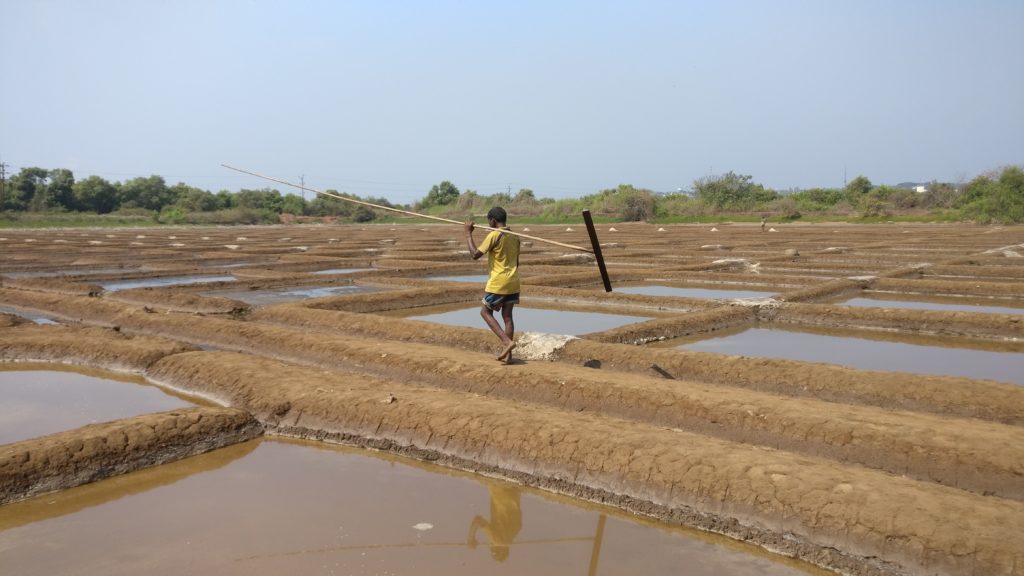
It has become highly difficult to find a skilled labourer in Goa as the younger generation is reluctant to learn the trade for want of more lucrative options. Added to that is the intensive labour involved and the declining demand for the unrefined salt that is an intimidating factor for the youth. Hence, out of 36 villages which produced salt in Goa earlier, only a handful of them are still functional to keep the occupation alive with the produce barely catering to the domestic market.
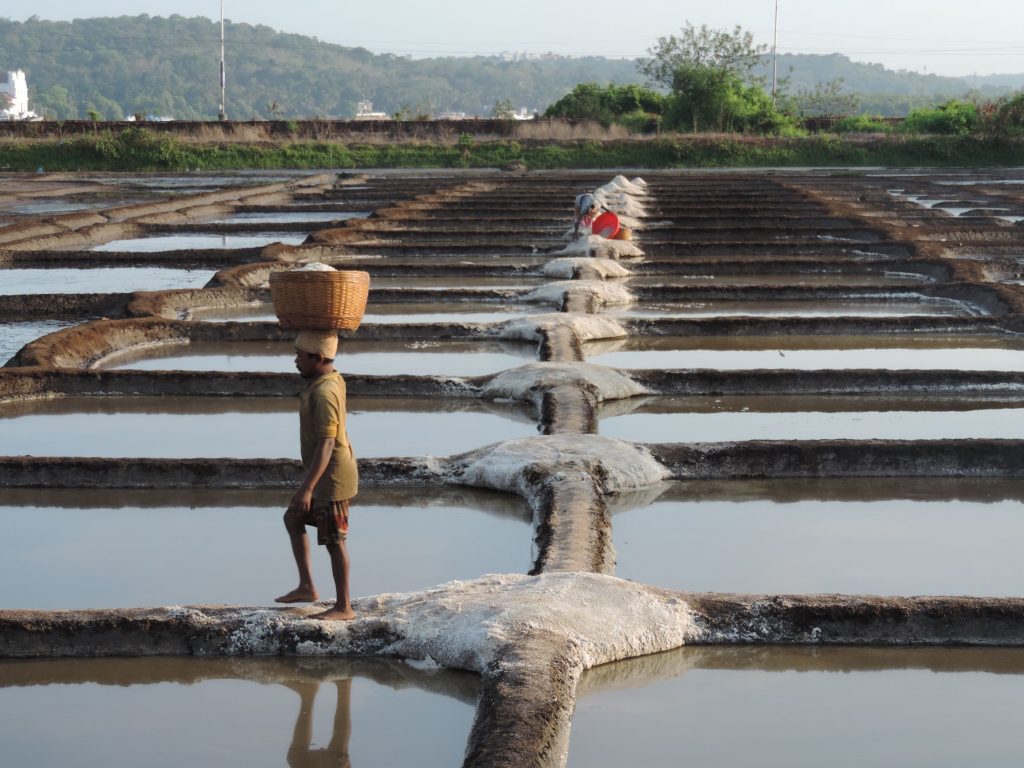
Michael, another mittkār from Batim, Goa, laments that his sons are least interested in the work he has learnt from his father at the age of 11. His sons don’t share their father’s passion as this would mean 10-12 hours of work every day under the sun. At 65, Michael works through the day not just to use his ancestral lands and continue this traditional occupation, but because this is the only work he has learnt. “I dropped out school after my 7th std and learnt the work from my father. Since then I have been working in these fields”, he said, with surprisingly good English for an ‘uneducated’ man. Michael is one of the few Goans who is still trying to hold on to his lands. During the monsoon days, he cultivates his land and grows traditional rice varieties that are grown is saline lands like Kohrgut, Assgo, Khochro etc.
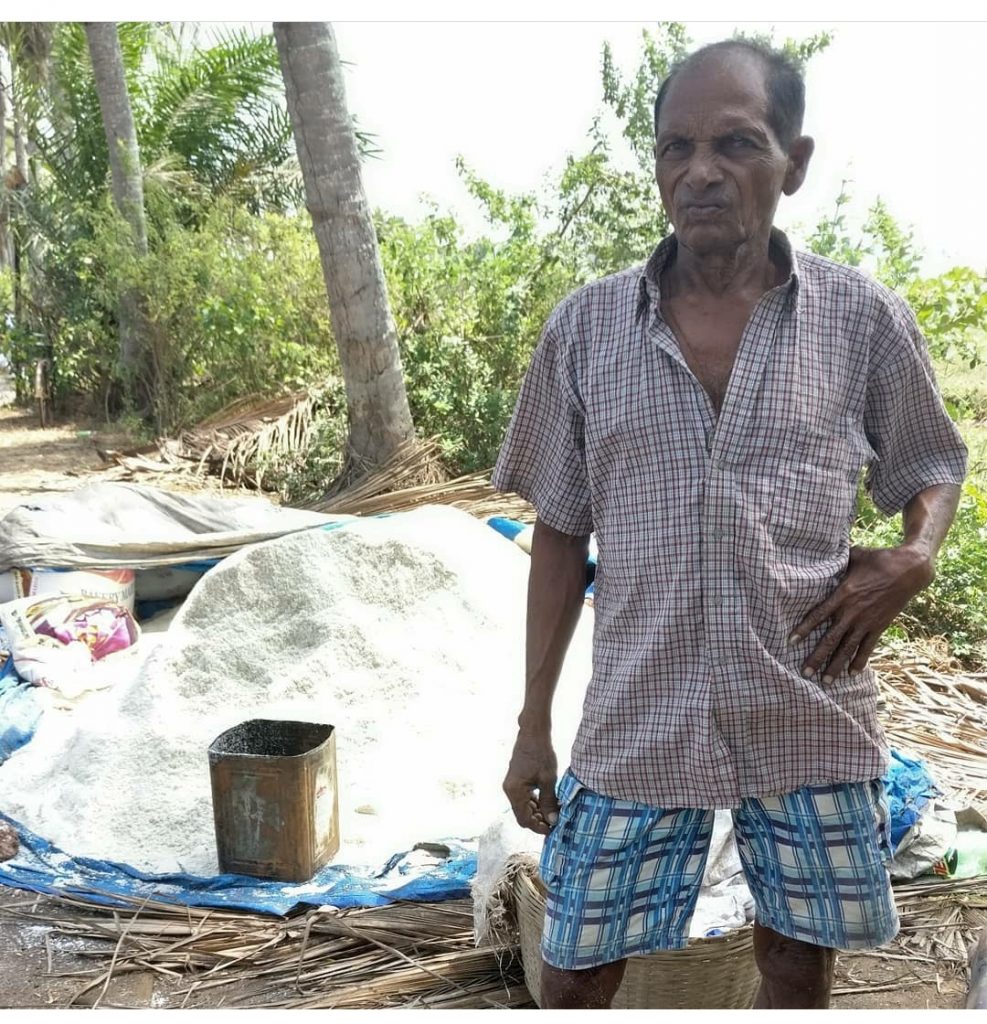
Khazan lands
Traditionally salt was made by the evaporation of sea water or by extracting salt from the salt mines. Local biodiversity and suitable geographical and climactic conditions are pre-requisites for the building of salt pans. Solar extraction needs saline water supply that is regulated using sluice gates built in two different places. The Ribandar salt pan, for example, gets its supply of water from the Mandovi River depending on the need and the movement of the tide. The khazan on the other side of the Ponte Conde de Linhares (the causeway connecting Panjim to Ribandar) gets filled up which then is allowed, when necessary, through the second sluice gate, to enter the beds provided for evaporation and crystallizing of salt. The salt thus extracted has essential minerals that disappear in industrially refined salt. Khazans are waterlogged reclaimed lands that are used for agriculture, fishing and salt-making.
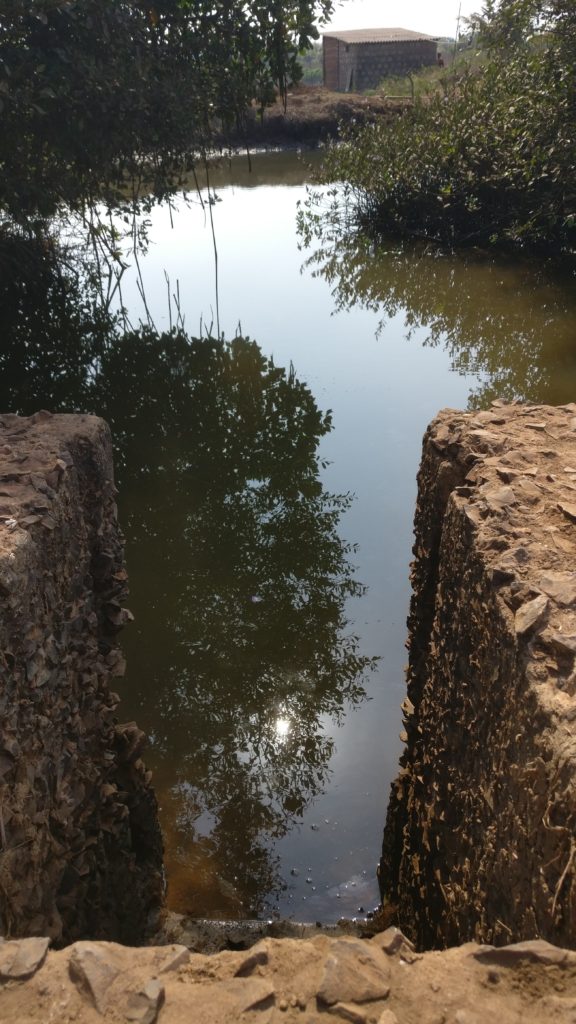
A visit to these places would expose the stark truths of the disappearing khazans from the Goan landscape, environmental pollution, shrinking of the mangrove cover all across Goa due to developmental activities and finally the general tendency of people who are moving away from healthier and indigenous food and culture for a more dangerous modern industrially and commercially made produce. Many of these lands are also being used by many for agriculture and pisciculture, which, many believe, is commercially more viable. Goa has many such khazans which are habitats for crabs, shrimp, mud skippers and also migratory birds. Hence destruction or abandoning of saltpans also affects the biodiversity of these hotspots or vice versa.
Pickling and more
Salt is not just used to enhance taste of food; its use as a preservative has been discovered thousands of years back. Many families in Goa still use the unrefined sea salt for curing their meats and making pickles. Preservation and drying of fish is another very important activity for which traditional salt is essential. Today, salt is being fortified with iodine and sometimes iron as deficiency of any one of these leads to serious illnesses. Additives are also used to make it free-flowing according to the dietary standards and Food and Drug Administration (FDA) regulations in each country. The Goan sea salt has a slight brownish tinge which comes because of the essential minerals and not because of any impurities. It has a distinct taste that gives food a burst of flavour. There are many families I know who use only the local sea salt for their daily food preparation.
Joaquim, Santo’s employer, leases out the land to the family every year and is happy with the produce that he gets. He does brisk business selling the salt to the local traders, as time is limited with the fast approaching monsoons that hit Goa by the end of May or beginning of June every year. The entire quantity of salt produced is not just for human consumption. The batch that is harvested initially is dirty and is hence used as a fertiliser for the coconut plantations that thrive in saline conditions. The salt produced subsequently is used for human consumption, explains Joaquim. He has good domestic market for both the varieties.
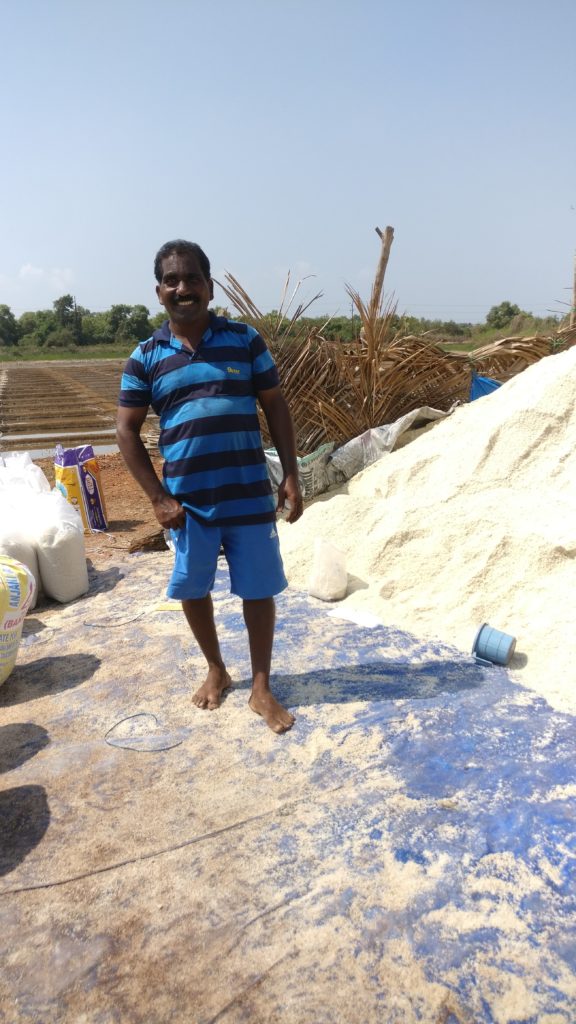
Goa being coastal area has reaped the benefits of salt-making and this occupation has been in practice for the last 1500 years. Saltpans, which are built in khazans, have helped the Goan mittkar (mīt is salt in Konkani) yield good amounts of salt enough for export in the earlier times. Like any other traditional occupation, salt making also is facing the modern challenges from the lack of skilled labour, mindless commercialization, lure of ‘better’ opportunities and ‘lucrative’ jobs, lack of government support, and of course declining demand for the product. Though some of the traditional skills and occupations die a natural death like pottery, some are only getting extinct for lack of suitable support from society and government agencies.
Economic Recession 2020
A visit to the pans is a ritual for me every year either to pick up a few bags of salt for my domestic use, or just to walk around watching the mittkārs work on the salt fields. This year, as the lockdown eased a little, I visited the salt pans in Ribandar, hoping that situation is not as bad as elsewhere. To my pleasant surprise, along with Santo, there were a few more people working on the salt fields, oblivious to the pandemic scare that has gripped the world. I was elated to know that salt business this year has not been drastically affected. I could not meet Joaquim but a chat with a worker (he was reluctant to reveal his name) who has returned from the field for a brief rest, told us that business is as usual and that the pandemic has not really affected the flow of their regular customers. Luckily, this is a time-bound occupation, and a commodity that is entwined with Goan traditional calendar. Hence the season closed on a positive note for the mittkārs of Goa.
Summer 2020 in Goa has changed many things in many ways. As the world woke up to the possibilities of an unpredictable future, in several ways, Goa too woke up to shocking realities – of recession, unemployment and a bleak future. It is heart-warming to see that many who moved away from traditional occupations, are coming back to till their lands to become self-sufficient. It is a sign of prosperity but time will tell whether this change is impulsive or permanent. I thought of Michael, whose sons were earlier reluctant to become mittkars or farmers and hoped that they have decided, after all, to assist their father in his work and preserve their precious lands.
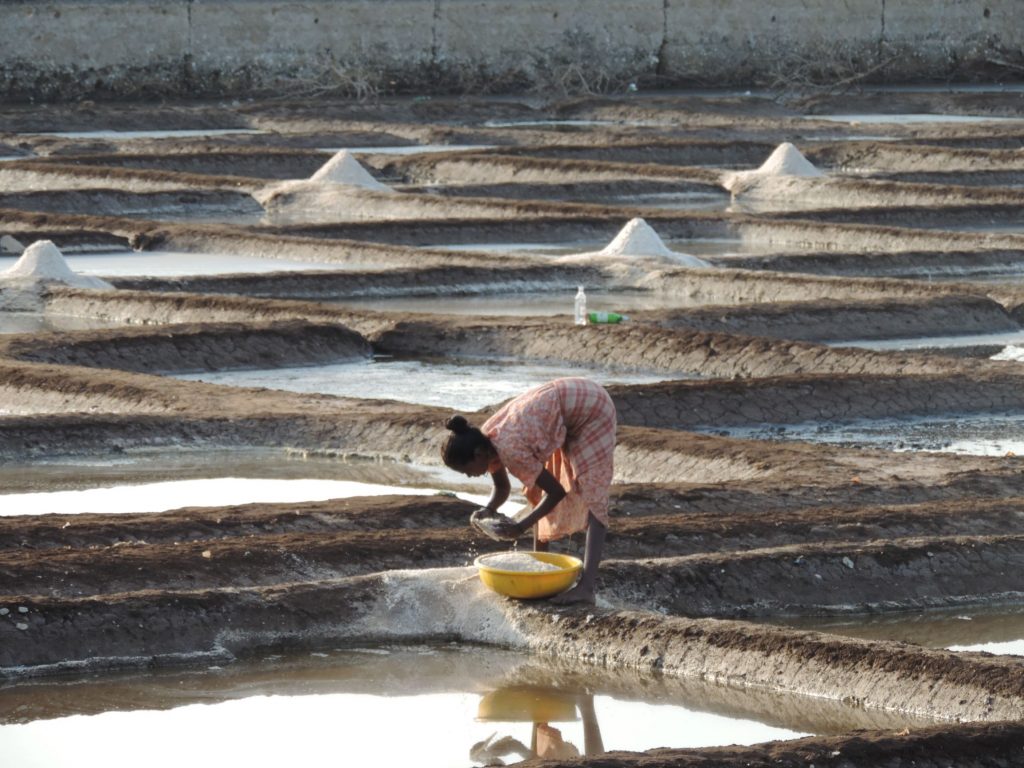
The history of salt recounts the history of human civilization. Its importance is not only as a seasoning ingredient but also as an important additive in several medicines. History states that wars have been waged, slaves have been exchanged, routes were laid, ceremonies were held and cities were named around the importance of salt to the humanity.
For Santo and Joaquim and their ilk, yesterday is already gone and tomorrow is yet to come but today is already here…and that is what matters the most.
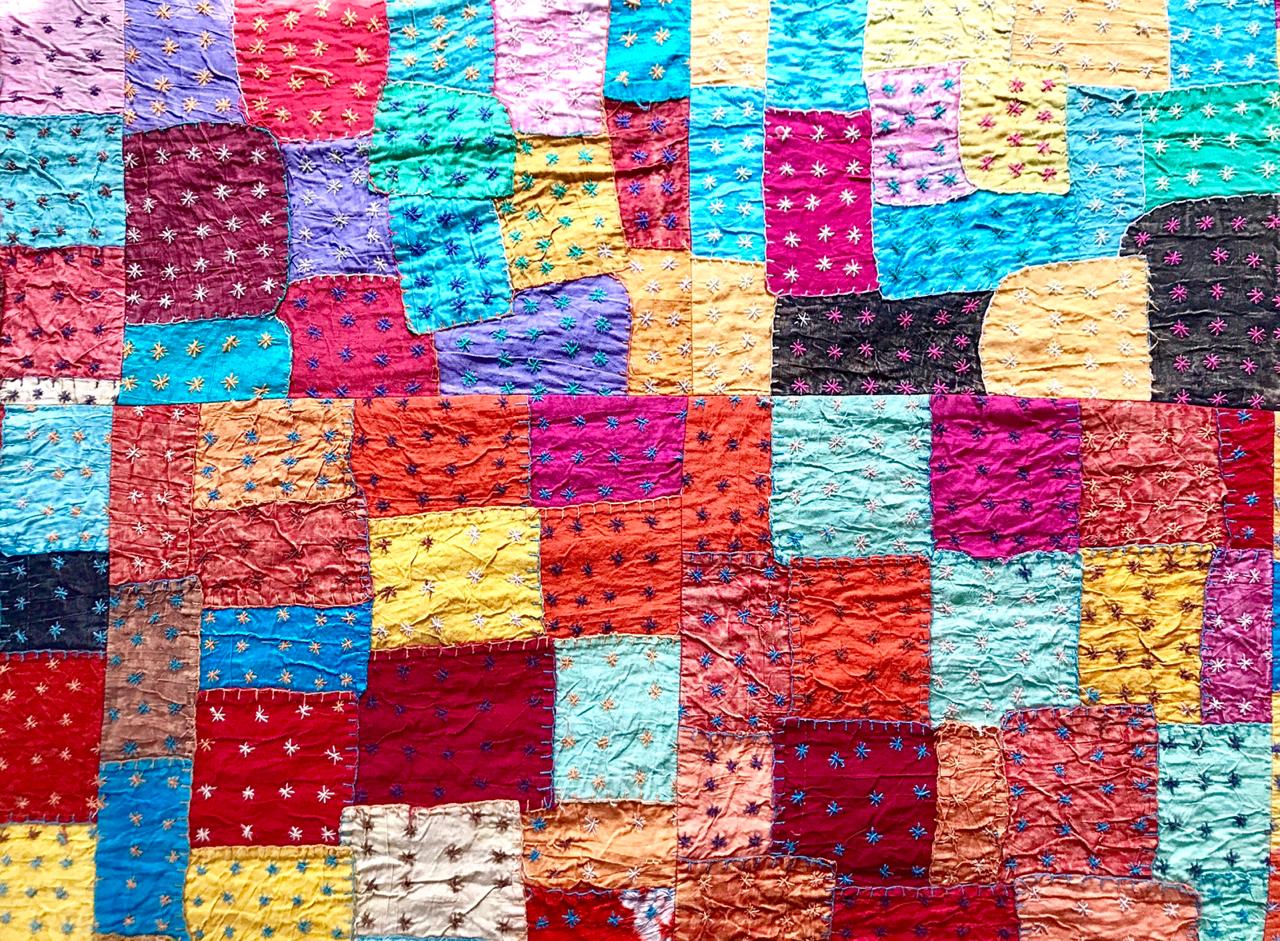
One of your best yet Jyothi! Can you figure out how to enlarge the photos when touched? Also, I am interested to know how the locals pronounce their names. Joaquim, for instance, is pronounced here as “Vakeem”.
Thanks a lot. About the pic, I will see what i can do about enlarging the pic. Maybe I need to add that feature in the settings.
Loved this story, gives a nice insight into the community. Thanks for sharing! Makes it even special, coming from a Goan. I always felt that in tourism dependent states like Kerala and Goa, visitors typically make a bee line to the beaches and don’t make an effort to discover a bit more of the local life. Hope the story evokes an interest and pride in the preservation of local culture, foods and a way of life.
It would be nice if we can get a supporting pronunciation of some of the Goan names and terms.
Thank you. Yes, please do